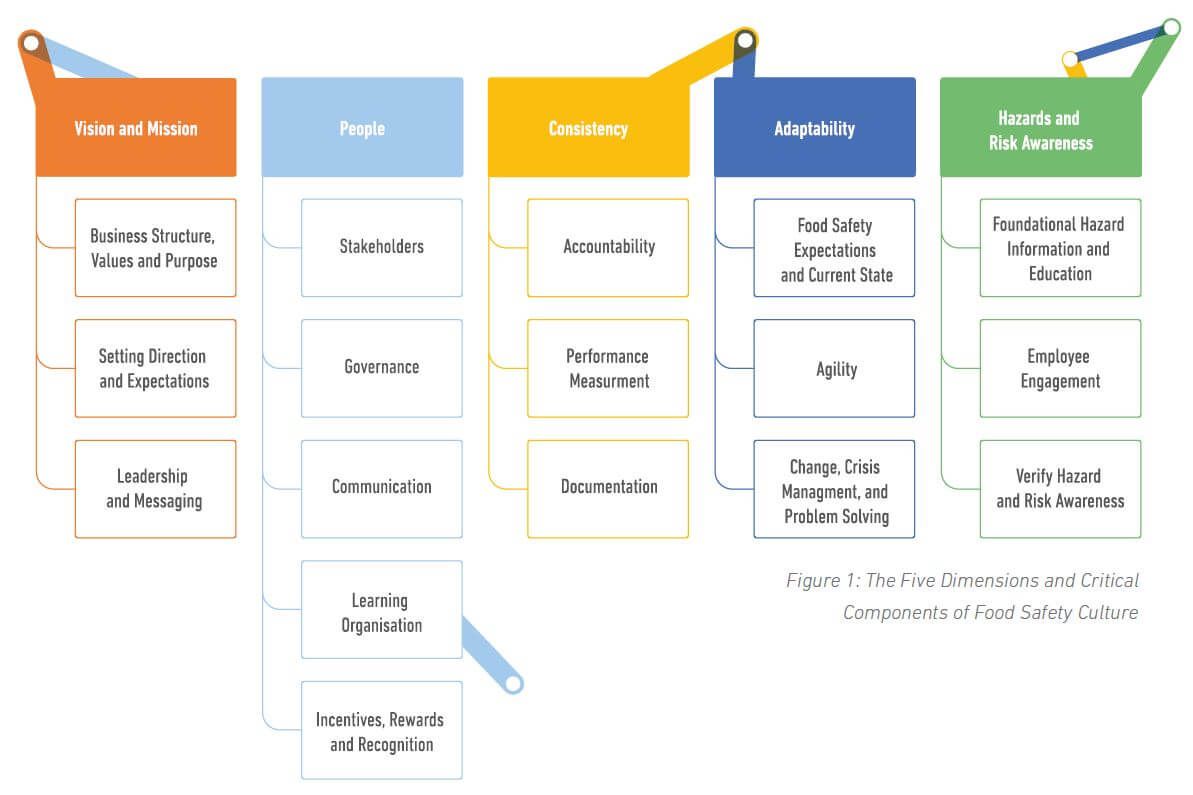Building a Positive Food Safety Culture in Your Organization
Introduction
We need capable and proven Food Safety Management Systems (FSMS), well-managed supply chains, suitable premises, and equipment but at the end of the day, it is people who produce safe food!
What people/team members learn from the bigger group in regards to food safety practices, what they usually do, and the norms and behaviors they share are what we refer to as food safety culture.
In this blog post, we will discuss the definition of food safety culture, its importance, and the benefits of having a positive one in your workplace. We will also provide tips on how to create maintain positive food safety culture in your organization.
What is food safety culture?
Here is the first definition, "the collection of values, attitudes, and practices that determine how food is grown, processed, transported, stored, prepared, and served." (International Food Safety Authorities Network [INFOSAN], 2016).
Also defined by BRCGS as " The attitudes, values and/or beliefs which are prevalent at the site, relating to the importance of product safety and the confidence in the product safety systems, processes, and procedures used by the site"
My favorite definition is from The Global Food Safety Initiative (GFSI), who defines it as "Shared values, beliefs and norms that affect mindset and behaviour toward food safety in, across and throughout an organisation." (Global Food Safety Initiative (GFSI) Technical Working Group, 2018).
In simple terms, it is what we learn from the bigger group and what we usually do when no one is watching.
Importance of food safety culture
While it has become a compliance requirement in a number of food safety standards and regulatory requirements, it is a focus area in FDA's New Era for Smarter food Safety initiative, also highlighted in Codex Alimentarrious guidelines - General principles of Food Hygiene CXC 1-1969 2020 version and by Food Standards Australia New Zealand, food safety culture is important because it can help prevent food safety incidents from happening.
Let's say that you are working in a food factory and you see one of your co-workers doing something bad, like not washing their hands when they should, let's say coming back from lunchtime straight to the production line. If you have a positive culture in your organization, you, and others too, are more likely to speak up and tell them that they need to wash their hands. However, if you don't have a good culture in your organization, you might not say anything because you might be afraid of getting in trouble or because you might not want to get into an argument with your co-worker.
But why all of this you may ask? It can help you achieve the following goals:
- Help to prevent foodborne illness outbreaks.
- Improve food safety performance
- Improve communication and coordination among team members
- Improve compliance with relevant regulations
- Improve product quality and customer satisfaction
- Help to create a positive work environment.
- Help to improve team morale.
Studies by the Queens School of Business and by the Gallup Organization, suggested that a disengaged workforce had:
- 37% higher absenteeism
- 60% more errors and defects
- 49% more accidents.
Where employees' engagement scores are low, organsiations have experienced:
- 18% lower productivity
- 16% lower profitability
- 37% lower job growth
- 50% fewer job applications
So, investing in your food safety culture and organisational culture, in general, is a winning investment right?
12 Tips for creating and maintaining a positive food safety culture in your organization

Provide full and practical training on the topic and how it applies in your workplace.
At Food Surety we deliver a comprehensive, BRCGS official "An Approach to Product Safety Culture Course" that will ensure your efforts are on the right track and provide you with many necessary tools you need.
Hold formal and regular stand-up training to reinforce food safety principles
A good example is to use standup training that is 3-5 minutes long with only one concept. If you want to teach people about food allergy protocols at work or foodborne illness incident handling, you might first ask your staff why the topic is important. Next, you should explain how you can apply it e.g. how to follow food allergy protocols. Make sure you quiz your staff about the specific protocol taught and pay attention to the proper record-keeping part of any refresher courses, it is an ongoing effort that can be made simple by using the proper training techniques and technology.
Senior managers to lead the initiative
Measure the current state
Here is one tip that you, as a food safety expert, should remember, your food safety culture efforts should be focused on improving behaviours! Not the product, not the shelf-life,...
Communicate to and engage everyone at the organisation
Make sure that everyone in your organization understands the importance of food hygiene in the employees' regular routine and has an up-to-date understanding of food safety protocols and preventing consumer harm and foodborne illnesses. Encourage employees to speak up if they see something that is not safe or if they have any questions about how to safely prepare food.
More Tips for a strong culture at the workplace:
- Establish and communicate food safety policies and procedures.
- Encourage team member communication and collaboration as well as reporting food safety violations.
- Monitor food safety performance e.g. using food safety inspections, and make cultural adjustments as needed.
- Have fun and celebrate team members who demonstrate food safety excellence in producing, handling, or serving food, those who identify non-compliance and isolate potentially unsafe foods, and of course those who have less careless mistakes
- Use posters to summarise and communicate information minimising language barriers
- Provide adequate resources and support to help the team maintain proper food safety protocols.
- Evaluate and update your plan regularly.
Once you have established a positive product culture in your organization, it is important to take steps to maintain it.

Conclusion
For more tips on creating and maintaining a positive culture or if you are looking for a food safety training provider? Please contact us today!
Frequently Asked Question
Q: How can I get my employees to be more food quality and safety-conscious?
Q: Is creating a food safety culture something that only large companies need to worry about?
Q: What should I do to engage team members in food safety culture efforts?
Q: How often should I evaluate and update my food safety culture plan?
Q: what if the survey results suggest a lack of positive safety culture?
Q: I'm not sure where to start with creating a food safety culture in my organization. Can you help?
Latest From Food Surety Blog

